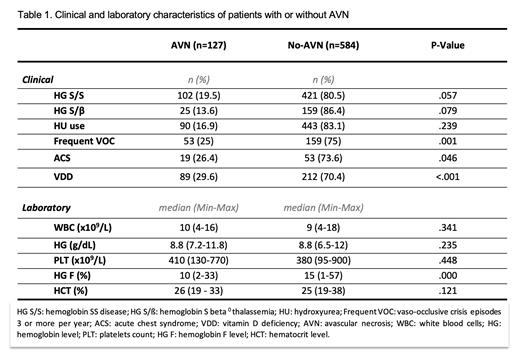Introduction
Sickle cell disease (SCD) is an inherited hemoglobinopathy with complex systemic involvement. Avascular necrosis (AVN) is a devastating complication among patients with SCD. Vitamin D deficiency (VDD) is commonly found in SCD patients, but there is limited research on the potential role of VDD as a risk factor for AVN in SCD patients. This study aimed to assess the association between VDD and AVN and determine the patterns, risk factors, diagnosis, and treatment of AVN in SCD patients.
Methods
We conducted a retrospective cohort study of consecutive SCD patients diagnosed with VDD from January 2020 to December 2022 at Prince Sultan Medical Military City (PSMMC) in Riyadh, Saudi Arabia. Patients meeting the following criteria were included: (1) adults and children with confirmed SCD through hemoglobin electrophoresis and (2) tested for VDD. Patients who underwent bone marrow transplant were excluded. The main outcome measured was the occurrence of AVN. VDD was diagnosed in patients with 25-hydroxyvitamin D levels below 30 nmol/L. Magnetic resonance imaging was used to stage and confirm AVN diagnosis. Associations were assessed using the chi-square test, and logistic regression was performed to control for confounding.
Results
The study included 711 eligible SCD patients, with 271 (38%) being children. VDD affected 301 out of 711 patients (42.3%). Among these, 212 (70.4%) were adults (>18 years old). VDD was observed in 32.2% of children and 48.1% of adults. Of the total cohort, 127 (17.9%) patients experienced AVN, including 18 children. Among patients with VDD, 89 developed AVN, while VDD affected 212 patients without AVN. The time between VDD diagnosis and AVN presentation ranged from 3 to 12 months. Male patients accounted for 52% of AVN cases. The average age at AVN diagnosis was 30.9 ± 11 years. The most common clinical presentation of AVN was chronic joint pain in over 95% of patients. Other presentations included limping in 3.9% of patients and limited joint movement in one patient. Affected joints included the hip (86%), shoulder (16.5%), knee (4.7%), and sacroiliac joint (0.7%). Bilateral joint involvement was present in 50.4% of AVN patients. The majority of patients (76.4%) were diagnosed with advanced stage AVN (III/IV). Treatment of patients with AVN included joint replacement in 44 (34.6%) patients, while the remaining 83 patients managed with conservative therapy such as pain control and physiotherapy. Patients with a history of VDD were significantly associated with a higher risk of AVN (p < 0.001), as seen in Table 1. Multivariate logistic regression showed SCD patients with VDD had 9.79 times the odds of AVN compared to SCD patients without VDD (OR 9.79; 95% CI: 5.25-18.26). Other statistically significant risk factors for AVN included frequent vaso-occlusive crises (three or more episodes per year), older age, history of acute chest syndrome, and low hemoglobin F levels.
Conclusion
AVN is a significant cause of morbidity in our SCD cohort, with most patients having advanced AVN disease. VDD is an independent risk factor for AVN in patients with SCD. Well-designed randomized trials are needed to determine the effect of vitamin D supplementation in reducing AVN in children and adults with SCD.
Disclosures
No relevant conflicts of interest to declare.


This feature is available to Subscribers Only
Sign In or Create an Account Close Modal